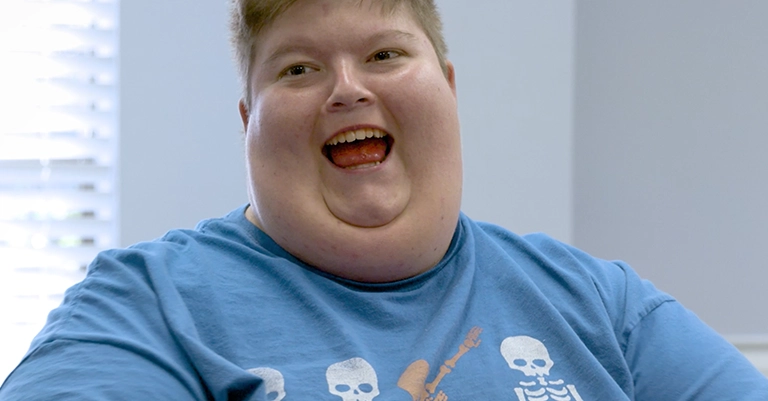Prader-Willi Syndrome (PWS) is a complex genetic condition that requires highly specialized management. Characterized by hyperphagia (or an inability to feel full), hypothalamic dysfunction, obesity-related metabolic complications, cognitive impairment, behavioral dysregulation, and multiple co-occurring conditions, it often demands a coordinated, interdisciplinary approach. While many children can be supported at home or in outpatient programs, there are times when symptoms escalate or safety becomes compromised. In these moments, an inpatient program provides the structured environment and integrated expertise needed to stabilize health and chart a path forward.
When to consider inpatient intervention.
Not everyone with PWS needs inpatient care — but for families facing severe challenges, the following factors often signal a higher level of care is warranted.
Rapid or life-threatening weight gain.
Hyperphagia is one of the hallmark features of PWS, often leading to dangerous, uncontrolled weight gain. Because patients have reduced caloric needs paired with an insatiable drive to eat, they may gain weight rapidly even under careful supervision. This puts them at risk for life-threatening complications such as acute gastric dilation, cardiopulmonary problems, Type 2 diabetes, heart failure, and sleep apnea.¹,² Inpatient care allows for close medical monitoring, swift intervention when crises occur, and stabilization of health markers that cannot be reliably managed at home.
An inpatient setting also provides the opportunity to reset nutrition and activity patterns under controlled conditions. Relying on secured environments, dietitian-supervised meal planning, and structured exercise programs, inpatient teams can not only slow the progression of obesity, but also teach families workable strategies for managing PWS at home. This combination ensures the patient’s immediate health is safeguarded while building sustainable routines that can continue post-discharge.
Severe behavioral dysregulation.
Beyond physical health, PWS is often accompanied by significant behavioral challenges that can overwhelm families and outpatient providers. These include compulsive food-seeking, skin-picking, mood lability, aggression, and resistance to change.³,⁴ When behaviors escalate to the point of endangering the individual or others, or when daily functioning becomes impossible, inpatient care provides a safe environment for stabilization. Clinicians can observe behaviors across contexts, collect data, and develop individualized behavior plans.
Co-occurring psychiatric or medical conditions.
Many individuals with PWS live with more than one significant diagnosis. Psychiatric concerns such as anxiety, obsessive-compulsive disorder, and psychosis may co-exist with complex medical conditions like scoliosis, abnormal respiratory function, and endocrine abnormalities.⁵,⁶ When multiple conditions converge, care needs can quickly outpace what outpatient providers are able to coordinate. Inpatient treatment enables the integration of psychiatry, psychology, internal medicine, endocrinology, and skilled therapy services under one roof, reducing the risks associated with fragmented care.
A comprehensive approach ensures that no single concern is treated in isolation. Psychotropic medications, for example, can be monitored in real time for metabolic side effects. The result is holistic stabilization — not only improving quality of life in the short term, but also laying the groundwork for long-term safety and functional progress.
Need for interdisciplinary care.
Because PWS touches nearly every aspect of physical and behavioral health, effective care requires expertise across multiple disciplines. No single outpatient provider can adequately address nutrition, endocrinology, behavioral health, psychiatric needs, physical therapy, occupational therapy, and communication skills all at once. Integrated inpatient programs solve this by assembling collaborative, interdisciplinary teams in one setting.³,⁵ This intensive, team-based approach accelerates progress and ensures care alignment.
Inability to manage food security at home.
Families of children with PWS often face an exhausting and never-ending struggle to maintain food security at home. ²,⁷ Inpatient environments remove this burden by providing complete control of food access. Kitchens are secured, meals are portioned and monitored, and consistent schedules reinforce predictability. This creates a therapeutic environment where patients can learn to live within clear, safe boundaries.
Structured food security also offers something critical for caregivers: respite and peace of mind. Knowing their loved one is in an environment free of food-related risks allows families to recharge and prepare for the transition back home. At the same time, inpatient programs provide families with education, modeling, and coaching to implement realistic food security systems that can be sustained once the patient leaves the hospital setting.
Continuous monitoring and measurable outcomes.
Inpatient programs offer something that outpatient care simply cannot match: continuous monitoring of physical health and behavior. From daily monitoring of nutritional status and vital sign checks to lab work and behavioral data collection, inpatient teams can make evidence-based adjustments in real time. Tools such as InBody scanners, wearable trackers, and standardized assessment tools help quantify progress, whether the goal is reducing obesity-related metabolic complications, improving sleep, or stabilizing behaviors.⁸
At Nexus Health Systems, data from the Jump Start Program show that inpatient treatment produces measurable outcomes. Patients stay an average of 154 days and achieve a 16.4% reduction in BMI. These numbers reflect significant changes in health, safety, and quality of life.
The Nexus approach to inpatient care for PWS.
At Nexus Health Systems, the Jump Start Program provides an inpatient treatment environment tailored specifically to children, adolescents, and young adults with PWS. From structured food security to integrated therapeutic and medical care, the program addresses both the urgent needs and long-term goals of each patient. More importantly, families gain the assurance that their loved one is receiving coordinated, whole-person care backed by measurable outcomes.
If you are a caregiver, provider, or referral partner seeking guidance on whether an inpatient program is right for someone with PWS, contact our care coordination team to learn more. Together, we can determine the right level of support to foster stability, safety, and long-term growth.

